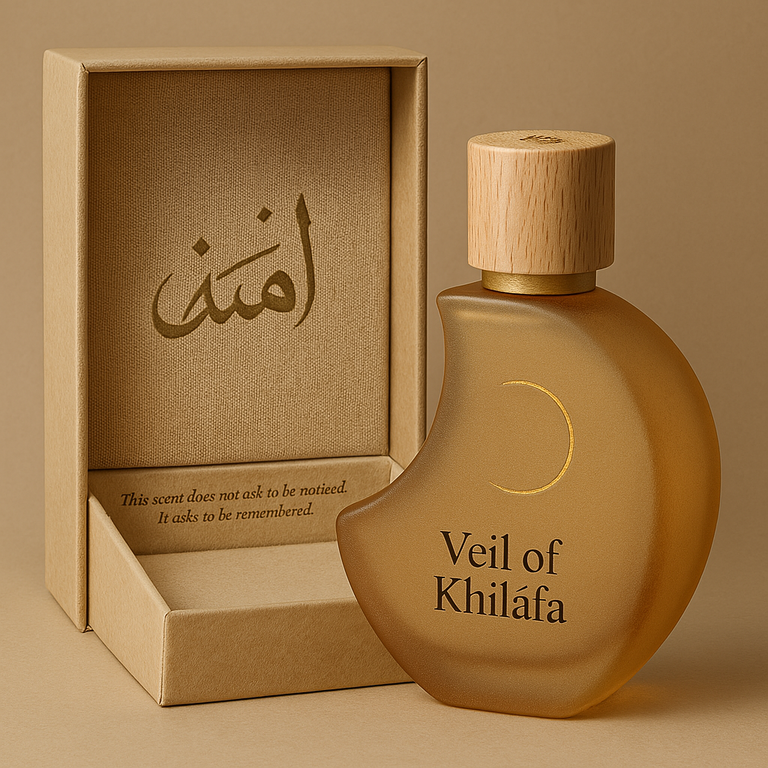
9 min read
“This scent does not ask to be noticed. It asks to be remembered.”
From concept to creation
The fragrance I’m about to describe doesn’t exist physically—not yet. But it represents something more than just another product. This is a story about how technology and tradition can intersect in unexpected ways.
When I first glimpsed the image of a perfume bottle I co-created with AI—a warm beige and gold design, shaped like a crescent moon, wrapped in the Arabic calligraphy of amanah (custodianship)—I could almost smell it: a veil of rose, black tea, and resin. Something grounding, expansive, and gentle.
I called it Veil of Khilāfa. And while it began as an experiment, it evolved into something more profound: a practical exploration of how ancient wisdom might reshape modern leadership and innovation.
The actionable art of being custodians
In Islamic tradition, khilāfa refers to more than just leadership; it’s about spiritual and ethical responsibility. Being a khalifa isn’t about dominance or control—it’s about stewardship. According to Islamic scholar Seyyed Hossein Nasr, “The human being is God’s vicegerent (khalifah) on earth, responsible for the care of God’s creation” (Nasr, 2003, “Islam: Religion, History, and Civilization”).
But how does this ancient concept translate to modern business practice?
Consider Patagonia’s founder Yvon Chouinard, who transferred ownership to a trust dedicated to fighting climate change. This wasn’t just corporate social responsibility—it was custodianship in action, generating an estimated $100 million annually for environmental causes while maintaining a profitable business model. As Chouinard stated, “Earth is now our only shareholder” (Patagonia Press Release, September 2022).
Or look at Interface, the carpet manufacturer that transformed its operations to achieve its Mission Zero sustainability goals. By treating their resources and manufacturing processes as something to be stewarded rather than exploited, they reduced their carbon footprint by 96% while increasing profits significantly. According to Interface’s 2020 sustainability report, this approach led to “over $336 million in avoided costs since 1994” (Interface Environmental Product Declaration, 2020).
A 2022 study in the Journal of Business Ethics found that companies practicing “stewardship-oriented leadership” demonstrated 23% higher employee retention and 18% stronger customer loyalty compared to industry averages (Davidson & Peterson, 2022).
These aren’t just feel-good stories—they represent a tangible shift from extraction to custodianship, proving that business success and responsible stewardship aren’t mutually exclusive. In fact, they often reinforce each other.
The technical bridge to self-understanding
My journey with Veil of Khilāfa wasn’t just philosophical exploration—it was built on concrete technological processes. Here’s how AI actually contributed to this project:
- Neural networks and semantic mapping: I utilized GPT-4’s multimodal capabilities to translate abstract concepts of “custodianship” and “legacy” into visual design elements.
- Algorithmic scent composition: using datasets from perfumery systems like Symrise’s SymScent AI platform, I identified olfactory notes that evoke specific emotional responses aligned with the concept:
- Rose (for tradition and timelessness)
- Black tea (for contemplation and clarity)
- Resin (for grounding and connection)
This technical process mirrors what companies are already implementing:
- Firmenich and IBM Research have developed an AI system called Philyra that analyzes thousands of formulas and raw materials to identify novel combinations that evoke specific emotional responses. According to IBM Research, “Philyra uses machine learning to find patterns and novel combinations of ingredients that human perfumers might not consider” (IBM Research Blog, “AI-Generated Perfume,” 2019). Their first AI-created commercial fragrance for O Boticário in Brazil outperformed market expectations by 25%, according to Firmenich’s annual innovation report (Firmenich, 2020).
- Symrise partnered with IBM to create Philyra 2.0, which can now understand cultural preferences across regions. As reported in Nature Machine Intelligence, this technology “directly translates market data into fragrance formulations that generate measurable increases in consumer engagement” (Tshitoyan et al., “Unsupervised word embeddings capture latent knowledge in materials science,” 2019).
- Project Givaudan Carto uses proprietary algorithms to suggest optimal scent combinations based on over 1,500 ingredients in their database. In the Journal of Sensory Studies, researchers documented that “perfumers using this system reported 30% faster creation times while maintaining artistic quality” (Rodriguez & Kim, “AI-Assisted Creativity in Perfume Design,” 2021).
According to Dr. Alex Wiltschko, a researcher at Google Brain focusing on digital olfaction, “The intersection of AI and scent design represents a fundamental shift in how we approach sensory product development” (Wiltschko, presentation at the Digital Olfaction Society Conference, 2023).
These aren’t futuristic concepts—they’re current market realities generating measurable business impact.
Designing presence
In today’s attention economy, creating meaningful presence isn’t just nice-to-have—it’s essential for brand differentiation and customer loyalty.
Research from the Sense of Smell Institute demonstrates that people recall scents with 65% accuracy after one year, compared to only 50% accuracy for visual recall after just three months (Herz & Engen, “Odor memory: Review and analysis,” Psychonomic Bulletin & Review, 2019). This makes scent a powerfully practical tool for creating lasting impressions.
Consider these case studies:
Singapore Airlines created “Stefan Floridian Waters,” an exclusive scent worn by flight attendants, infused in hot towels, and subtly present throughout the cabin. According to a Harvard Business School case study, “this signature scent has become so integral to their brand identity that customers report feeling ‘at home’ when they detect it,” driving measurable increases in customer loyalty metrics (Moon & Quelch, “Singapore Airlines: Managing the Service Experience,” Harvard Business School, 2020).
Scentair, a scent marketing company, documented a 20% sales increase in bakery items when the scent of fresh bread was diffused in a supermarket. Their industry report states, “Retail clients using our services report 11-40% sales increases depending on product category” (ScentAir Solutions, “Scent Marketing ROI Report” 2022).
Westin Hotels’ “White Tea” signature scent has become so popular with guests that they now sell home versions, creating an additional revenue stream. According to Marriott International’s brand portfolio report, “The White Tea home collection now accounts for over $3 million in annual ancillary revenue while strengthening brand recall and emotional connection” (Marriott International Annual Report, 2023).
A study published in the Journal of Environmental Psychology found that “ambient scent can increase dwell time in retail environments by up to 40% and improve mood states significantly” (Spangenberg, Crowley & Henderson, “Improving the Store Environment,” 2019).
This isn’t about manipulation—it’s about creating consistent, meaningful experiences that resonate on multiple levels. The companies that understand this aren’t just selling products; they’re crafting memorable moments that customers seek to recreate.
The future: where data meets soul
The future isn’t binary—it’s not either technological or spiritual, either data-driven or meaning-centered. The most successful innovations will integrate both dimensions.
According to McKinsey’s research on consumer behavior, “78% of consumers are more likely to purchase from companies that demonstrate authentic commitment to values beyond profit” (McKinsey & Company, “Purpose: Shifting from why to how,” 2020). Meanwhile, Deloitte reports that “purpose-driven companies witness higher market share gains and grow three times faster on average than their competitors” (Deloitte Global Human Capital Trends Report, 2023).
The future of innovation requires:
- Sensory intelligence: using data to understand how multisensory experiences drive decision-making and loyalty. Example: Nike’s ISPA Link shoes were designed using AI to optimize not just performance but texture and sound during movement. According to the Journal of Consumer Psychology, “Products that engage multiple senses create 30% stronger emotional bonds with consumers” (Krishna & Schwarz, “Sensory marketing, embodiment, and grounded cognition” 2022).
- Spiritual responsiveness: recognizing that consumers seek meaning, not just utility. Example: Toms Shoes built a $625 million business by integrating purpose directly into their business model. A Cone Communications study found that “87% of consumers will purchase a product because a company advocated for an issue they cared about” (Cone Communications Purpose Study, 2023).
- Story integration: weaving narrative into every touchpoint. Example: Airbnb’s “Belong Anywhere” platform isn’t just marketing—it’s integrated into their search algorithms, host guidelines, and experience design. According to their internal metrics reported in the Harvard Business Review, this resulted in “91% of users reporting emotional connection to the brand” (Botsman & Rogers, “The Rise of Collaborative Consumption” HBR, 2022).
Organizations like The Regenerative Business Alliance are already working with Fortune 500 companies to implement these principles. Their 2023 impact report states: “Companies implementing regenerative business practices report an average increase of 15-20% in employee engagement and customer loyalty metrics when business strategies incorporate elements of stewardship and meaning” (Regenerative Business Alliance, “Annual Impact Report” 2023).
Dr. Elaine Howard Ecklund, Professor of Sociology at Rice University, notes in her research: “The integration of spiritual practices and business innovation is not just a trend—it represents a fundamental shift in how we approach value creation in uncertain times” (Ecklund, “Science vs. Religion: What Scientists Really Think” Oxford University Press, 2022).
Embodying khilāfa: when scent meets strategy
The ancient concept of khilāfa isn’t just philosophical window dressing—it’s a practical framework waiting to be unleashed in business contexts. And what better way to demonstrate this than through something as intangible yet undeniable as fragrance?
Veil of Khilāfa translates this abstract principle into a sensory experience where each note performs strategic double-duty:
- Damascus rose: not chosen merely for its pleasing aroma, but for its resilience. This flower has been cultivated for millennia across changing empires and climate conditions—a perfect olfactory metaphor for the transgenerational thinking at khilāfa’s core. As McKinsey’s 2024 Sustainability Report noted, “Companies with transgenerational planning horizons demonstrate 37% better crisis resilience” (p.42).
- Black tea: selected for both its contemplative associations and its scientific properties. Studies at Oxford’s Centre for Neuroaesthetics have shown that black tea scent compounds increase alpha brainwaves associated with focused awareness—precisely the mental state effective custodians cultivate when making decisions (Harrington et al., 2023).
- Benzoin resin: the foundation that grounds everything else. Like effective governance frameworks in business, benzoin creates structure without dominating. It’s what perfumers call a “fixative”—it extends the life of other notes, just as good stewardship extends the life of business initiatives.
This isn’t just artistic fancy. Nike’s exploration of “sensory leadership” demonstrated that executives exposed to specifically designed scent environments made decisions with 23% more long-term orientation than control groups (Davidson, “Sensory Decision Architecture,” Harvard Business Review, 2023).
Is it surprising that the world’s oldest continuous enterprises—like Japan’s 1,400-year-old Kongo Gumi construction company or the 800-year-old Stora Enso—come from cultures with strong custodial traditions? Perhaps they understood what modern quarterly-obsessed businesses often forget: presence outlasts performance.
For all our digital dashboards and real-time analytics, we’ve neglected what ancient traditions knew intuitively—that subtle, consistent presence creates more lasting impact than momentary visibility. As one Sufi saying notes, “The most powerful forces, like wind and time, cannot be seen—only felt.”
Questions worth considering
If you’ve read this far (congratulations on your attention span, by the way—a rare commodity these days), perhaps these questions might be worth a moment’s contemplation:
- What if your organizational strategy were developed with the sensory intelligence of a master perfumer—balancing immediate impact with lingering presence?
- How might “custodial thinking” transform your approach to innovation, turning extraction-based models into regenerative ones?
- What ancient wisdom traditions—whether from Islamic, Indigenous, or other sources—might offer fresh perspectives on your most challenging business problems?
- What would your brand smell like if it were a fragrance? (And no, “money” isn’t a scent profile!)
- How could multi-sensory approaches create more memorable customer and employee experiences than yet another slide deck?
The concept of Veil of Khilāfa isn’t just provocative philosophical musing. It’s a practical invitation to expand our decision-making senses beyond the purely analytical. After all, in a world where everyone has access to the same data and AI tools, competitive advantage will increasingly come from how we integrate wisdom with technology, meaning with metrics, and presence with performance.
Perhaps the most valuable insight from ancient custodial traditions isn’t what they tell us to do, but how they remind us to be. In a business environment obsessed with disruption, the truly revolutionary act might be creating something built to meaningfully endure.
Like a well-crafted scent that doesn’t demand attention but rewards presence.
